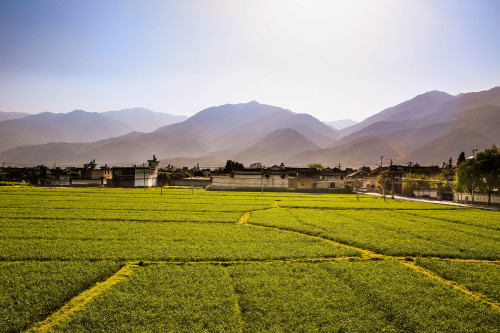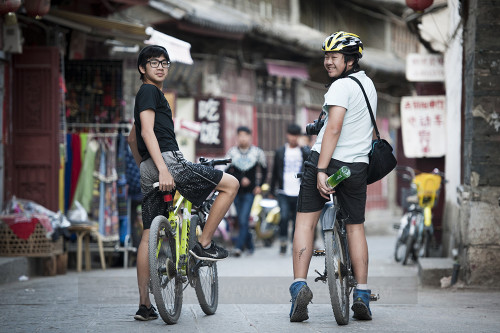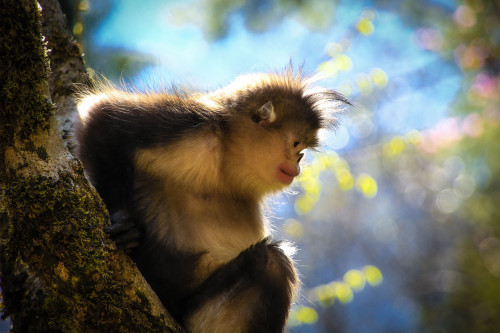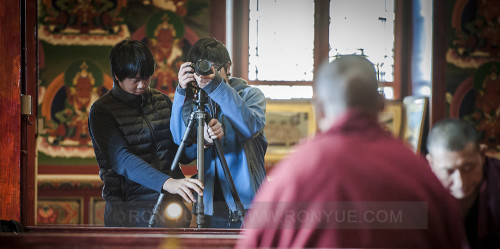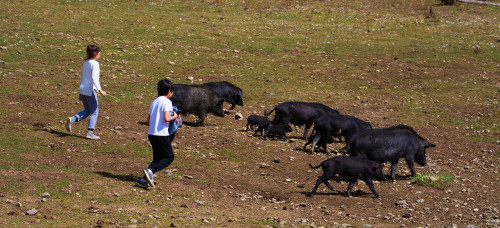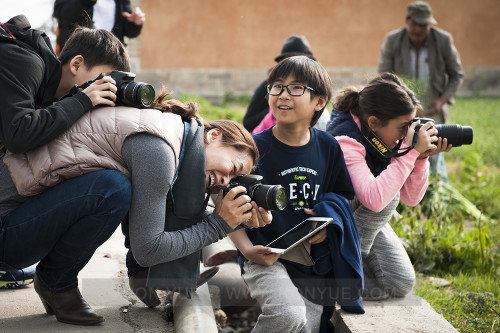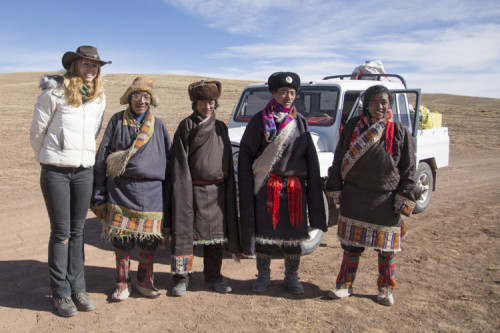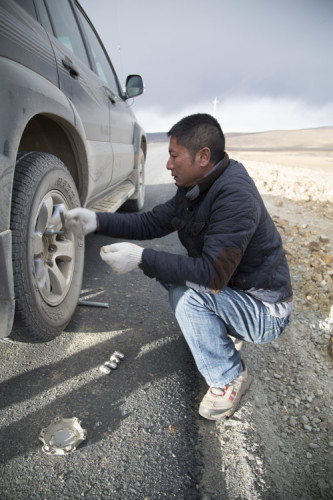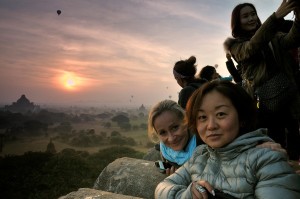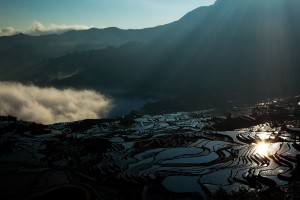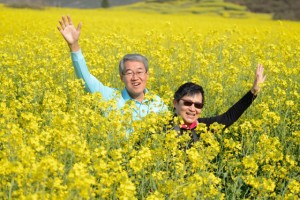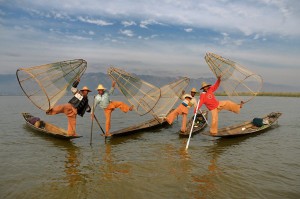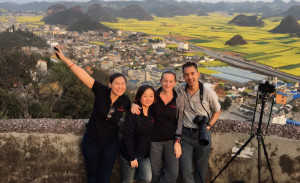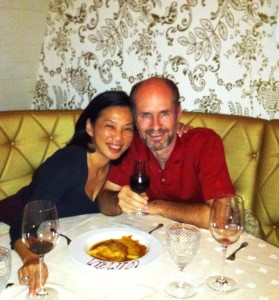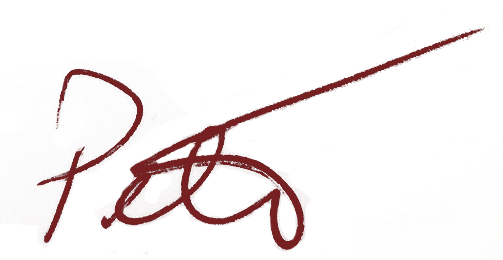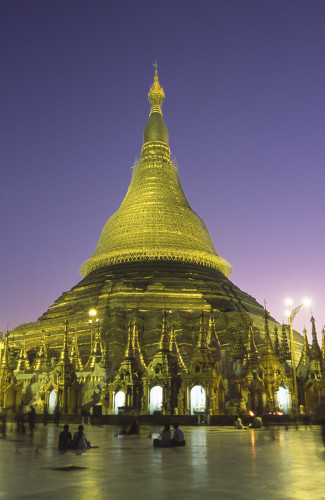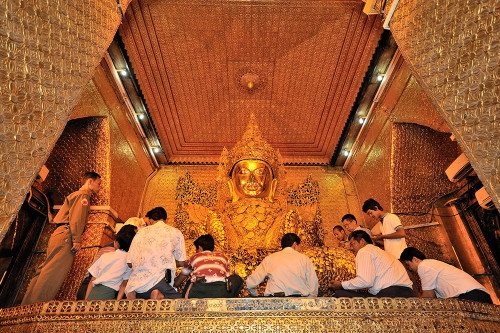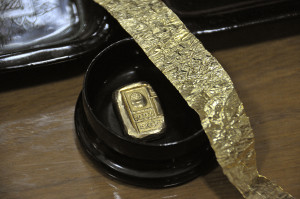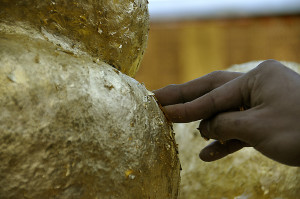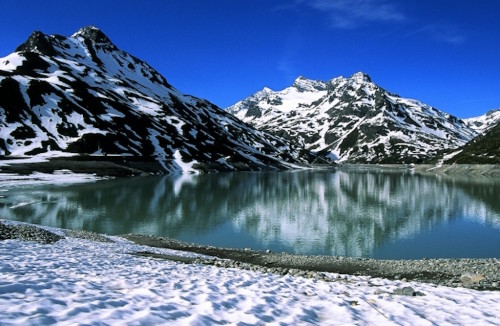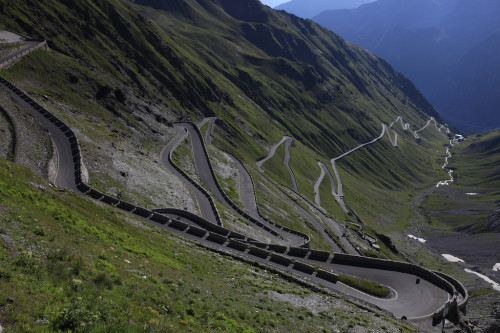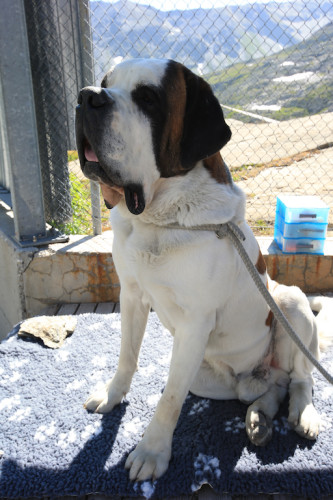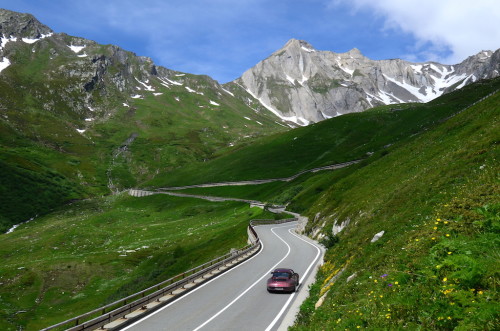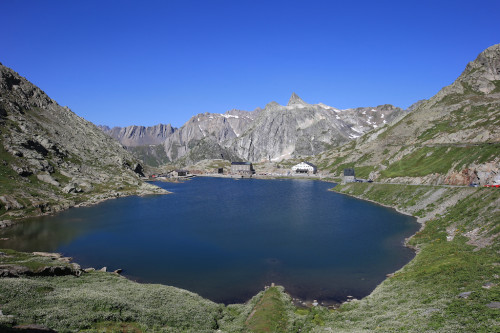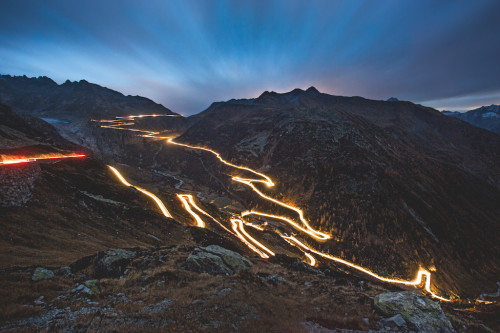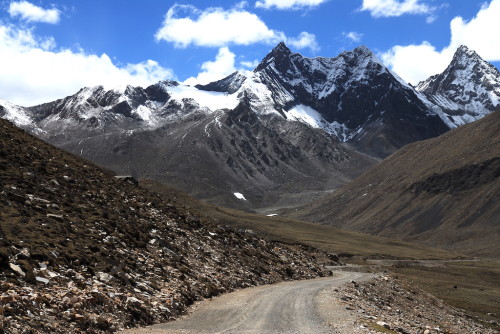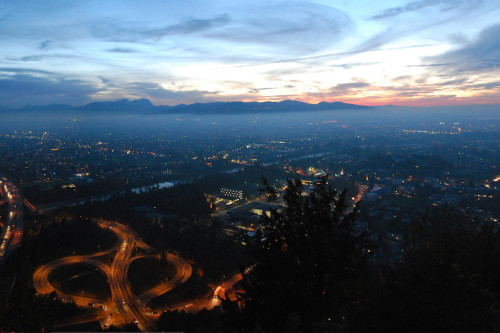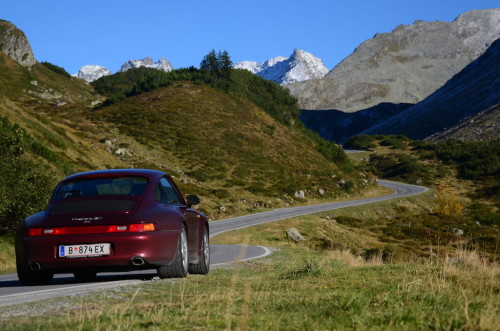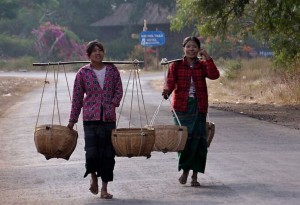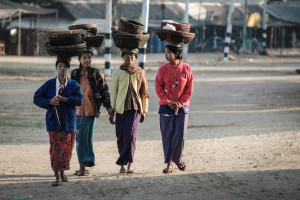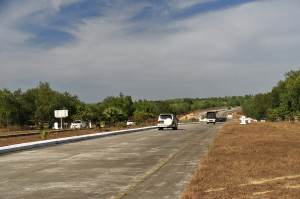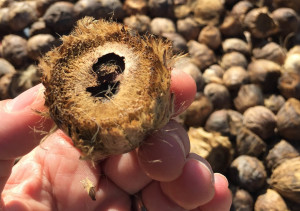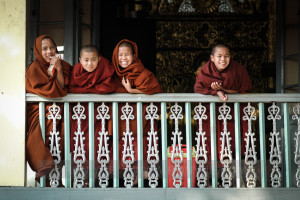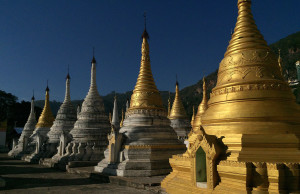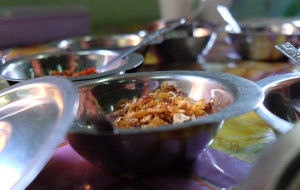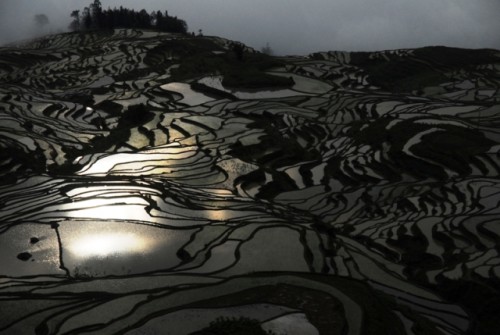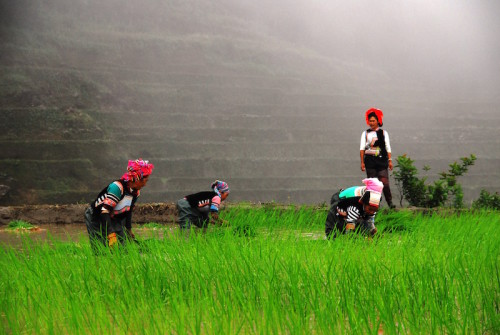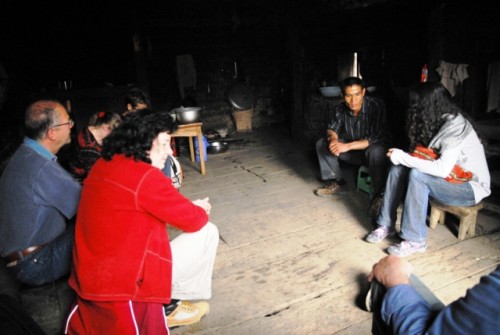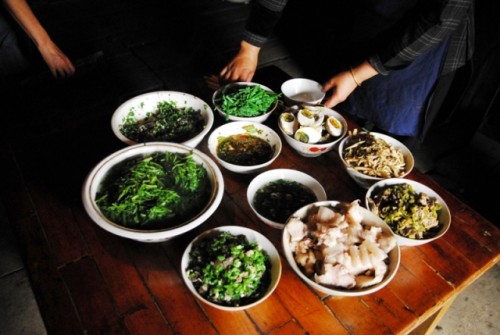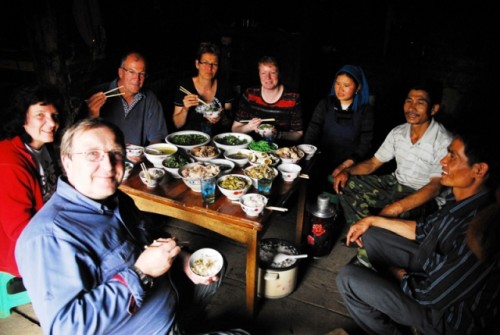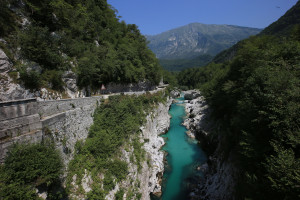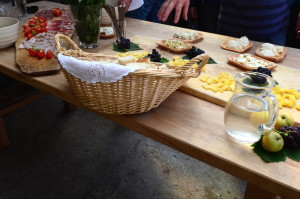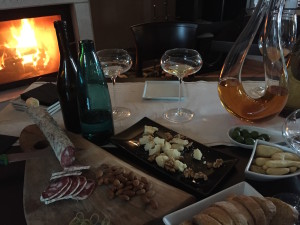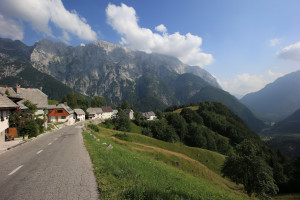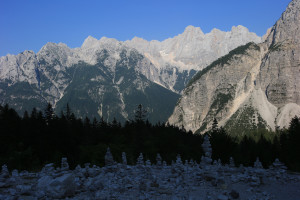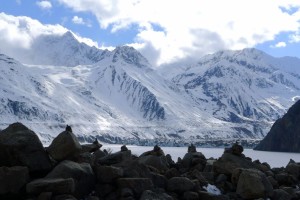Category: Uncategorized
Posted on 15 Apr, 2016
When we first came up with the idea behind “Adventures in Yunnan”, we weren’t sure how it would be received. We had a hunch that a family driving holiday in Yunnan could be great fun, but would anyone be adventurous enough to join us with their kids?
We put together a 10-day family-friendly journey that ran from Kunming to Lijiang in short chunks with plenty of interesting stops along as many quiet back roads as possible, and began to spread the word. Four daring families signed up for the first trip and off we went. The question now was how long would it take before the cry of “Are we nearly there yet?” was heard?
After leaving Kunming, our first stop was at Yunnan’s Dinosaur Valley, the site of a “dinosaur graveyard” where palaeontologists have unearthed hundreds of complete dinosaur skeletons since excavation began in the 1930s. Armies of reconstructed dinosaurs seem to march across the main hall, while scientists work away below, discovering yet more ancient bones. Exciting enough in its own right, when coupled with the small theme park that surrounds the museum, we had a hard time persuading anyone to leave – even with the promise of lunch ahead.
That first day’s drive ended in Xizhou, home of the Linden Centre, one of our favourite hotels in the region, and – it turns out – a great place for families with children. The second morning saw us walking through the rice fields and into the village to see the daily market, where our guests practised their Mandarin as we stocked up on Xizhou baba, a delicious local snack of fried dough smeared with rose jam. The region around Xizhou and Dali has plenty of other activities on offer, and that first trip saw us riding a cable-car up into the Cangshan Mountains to visit a Taoist temple, cycling down quiet village lanes and eating cream cakes in a German-run bakery – making it well worth the two nights we spent there.
From Xizhou we drove on to Shaxi, a small village packed with well-preserved examples of traditional Bai architecture. Our group walked out into the cornfields, picnicked and happily poked about the village streets – really a world away from the choked city streets of Beijing or Shanghai that often spring to mind when thinking about travel in China.
On leaving sleepy Shaxi, we drove up the Yangtze Valley to the tiny hamlet of Tacheng. The upper reaches of the Yangtze Valley (where the river is known in Chinese as the Jinshajiang, or “River of Golden Sand”) are wonderfully scenic, with thickly forested slopes dropping away to the sandy riverbanks. Tacheng lies at the edge of the Baimashan Nature Reserve in an area famed for its biodiversity. We made time here to drive up into the reserve to spy on its most adorable residents – troops of Yunnanese snub-nosed monkeys munching on the moss that festoons the reserve’s ancient trees.
Beyond Tacheng it was a steep climb to the Tibetan region around Shangri-La, where we petted yaks and visited a Tibetan family in their home. There, our guests had the opportunity to try tsampa, a dish of ground roast barley mixed to a paste with tea and butter. Younger members of the group announced it was “just like Play-doh” and spent a happy half hour moulding it into animal shapes, before heading off for a more spiritual stop at the huge Ganden Sumtseling Monastery.
Our last few nights were spent in the bustling city of Lijiang. One of Yunnan’s most popular destinations, this town lies in a beautiful valley dotted with pretty villages and headed at its northern end with the 5,600 metre-tall (18,360 feet) Jade Dragon Snow Mountain. Between horseback riding and watching a fantastic open-air show in the mountain’s shadow, trying to find our way through the labyrinthine old town and playing in the hotel pool, before we knew it the trip was over and we were on our way to the airport to fly home.
Did anyone – parents or children – ever ask if we were nearly there yet? No, not to my memory! As a host, this itinerary really was one of my favourites. Our younger guests revelled in being taken out of their everyday environment and exposed to so many new and interesting things. Every day my colleagues and I were asked a slew of new questions, every day we staff saw something afresh through the children’s eyes, or had our attention drawn to something we hadn’t noticed previously.
“Adventures in Yunnan” has gone on to become one of our most popular itineraries, with multiple departures each year timed to coincide with the school holidays. Recently we’ve added a photography-themed version of the journey, where our photographer Ron coaches guests through a fun series of travel photography field workshops.
One of the fathers from that first trip later told me, “Because your team took care of everything, we were encouraged to do something more daring than we would have attempted on our own, but now we’ve been inspired…” Since then they’ve been travelling all over Asia as a family – be warned, adventures as a family can become addictive!
Our family-oriented journeys include:
“Adventures in Yunnan“
“Family Adventures: Travel Photography in Yunnan” (with Ron Yue)
Posted on 30 Mar, 2016
Recently, I watched a documentary about Gwen Moffat, a redoubtable British climber who kept climbing into her 70s. The filmmaker asked Ms Moffat, now aged 91, if she missed the mountains. She answered, simply, “No, I don’t – they’re part of me you see, I had my time and now the hills are part of me.”
This idea – that some experiences become a part of us – is something that resonates with me, particularly this year. After years of fairly adventurous travel for work and pleasure, 2015 and (so far) 2016 have seen me on “home leave” after having a baby.
During that time, I’ve found my thoughts returning repeatedly to past travels, to places I’ve visited and people I’ve met. After writing last year about how anticipation heightens an experience’s pleasure, I’ve realised afresh that remembering a journey enables one to experience the joy of it all over again.
Of course, a memory can be sculpted into a superior version of the lived experience. I can omit the leech bites from an impromptu jungle trek in Malaysia, I can forget the physical pain of the bumpy journey to and from Indawgyi Lake in northern Myanmar, and I can delete my sweaty panic from a bike ride along New Zealand’s beautiful Queen Charlotte Sound to catch a ferry.
But instead, the memories that I recall most fondly aren’t the ones that I’ve manicured to remove the ragged edges from – they’re memories that involved some measure of personal challenge, difficulty or plain ridiculousness. That’s because they make better stories (whether I’m telling those stories to myself or to others), but also because those experiences shape my idea of what I’m capable of – even if it is a level of previously unthinkable idiocy…
As Ms Moffat says of the peaks she’s climbed, the memories of roads taken and journeys made have become part of me, and enable me to “travel” even when I’m sitting at home on a rainy afternoon. That’s what I call a souvenir…
Posted on 28 Mar, 2016
Since our last update in December, Christmas and the Western and Chinese New Years have come and gone…
Looking back…
In January, Mareen and Nancy, accompanied by Htein Linn, a Burmese photographer, went to Burma for three-and-a-half weeks. This on-the-ground research, together with knowledge gathered over the years, formed the basis for our first Burma itinerary (about which more below).
In March, Mareen, Nancy, Ron, and Fiona hosted a group of guests, many of whom have previously joined quite a few of our journeys, on a new itinerary, Yunnan through a Lens: Red Earth and Fields of Gold.
One of the guests told us after the journey that: “…we had a wonderful trip, passing thru the most beautiful scenery ever. Mareen, Nancy & Fiona served us really well with their heart, that we appreciate & Ron has been a most professional mentor, patiently coaching the least qualified photographer like us. Our driver Mr. Wu was such a cautious driver with excellent driving manners.“
Looking forward…
Burma really is the next big thing for us. In the next few weeks, we are very pleased to be able to share more information about our first Burma journeys. For now though, we can tell you:
-
The first journeys will depart 9 November, 2016 (4 cars booked, 1 more car available) and 29 November, 2016 (available). January 2017 is fully booked and Feburary 2017 (available).
-
You can view our all-new Journey Dossier here.
-
For those of you in Hong Kong, we will organise a Burma talk-and-dinner event in May.
We’re hiring… We are looking for journey hosts. If you know anyone like Mareen, Nancy or Peifen, our wonderful journey hosts, please let them know that we are hiring and ask them to visit our “Join us” page.
Between May and September, we are offering journeys for photography lovers, for families with children and more. In case you’ve missed our announcements, please take a look at the schedule below:
Searching for SHANGRI-LA – April 8th & 29th and July 15th
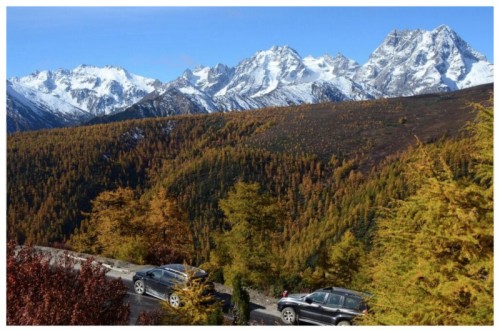 Our most popular Yunnan journey…
Our most popular Yunnan journey…- Why go? Read our blog essay right here…
- In a nutshell
- What?
- In just a few days, see how beautiful China can be!
- Discover where Shangri-La really might have been!
- Stunningly beautiful boutique hotels, along back roads, far away from the crowds.
- What?
- How long? 7 or 9 days
- How much? Starting from CNY23,700/person
- Click here for yet more info
PHOTOGRAPHY: Yunnan through a Lens: Tea Horse Trails – June 3rd
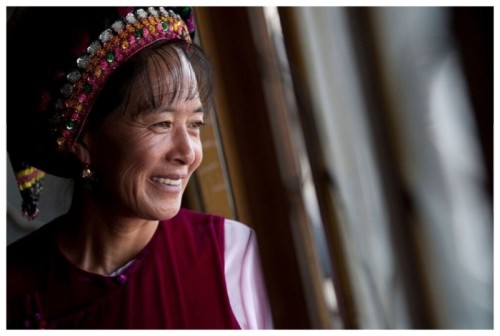 For photography lovers…there’s nothing like working with Ron!
For photography lovers…there’s nothing like working with Ron!- Read Ron’s recent short essay about travel photography in this region…
- In a nutshell
- Where? Hidden gems of Yunnan along the tea horse trail
- What?
- Capture moments with your camera like never before.
- Work, hands-on, with Ron and learn his techniques for portraits, landscapes, architecture, low-light and many other situations.
- How long? 6 or 9 days
- How much? Starting from CNY29,600/person
FAMILY: Adventures in Yunnan – July 4th and July 15th
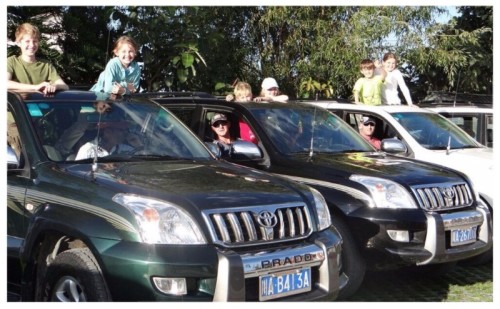 An unforgettable adventure for the whole family!
An unforgettable adventure for the whole family!- In a nutshell
- What?
- Experiences, not things!
- Haggling in the markets (in Pugonghua), gentle hiking, batik making, up-close-and-personal encounters with a Tibetan family…
- Memories of a great time together!
- What?
- How long? 8 or 10 days
- How much? Starting from CNY78,000 (for a family of 4) less early-bird discount of 10% for those who book by March 31st!
FAMILY & PHOTOGRAPHY: Travel Photography with Ron Yue – June 24thand October 21st
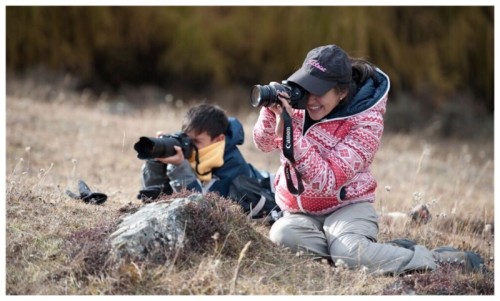 Start the holidays with a Family Adventure with Master Photographer Ron Yue
Start the holidays with a Family Adventure with Master Photographer Ron Yue- Click here for more info and read Ron’s latest blog entry about photography…
- In a nutshell
- What?
- Give your children the gift of photography…to see beauty everywhere!
- See beauty where others don’t, learn to simplify life, re-learn the value of patience…
- What?
- How long? 8 or 10 days
- How much? Starting from CNY84,720 (for a family of 4) less early-bird discount of 10% for those who book by March 31st!
CROSSING BORDERS into Lao and Vietnam – May 13th and September 16th
 Travel through ancient Asian Border Lands
Travel through ancient Asian Border Lands- In a nutshell
- What?
- At the best times of the year…
- … drive from Yunnan via northern Lao to Mai Chau in Vietnam.
- Discover, along back roads, a region brimming with different minorities…
- What?
- How long? 9 days
- How much? Starting from CNY39,900 less early-bird discount of 10% for those who book by March 15th!
- Alternative date September 16th : For a longer version “Summit to Sea: Yunnan to Vietnam”, please write to us for details.
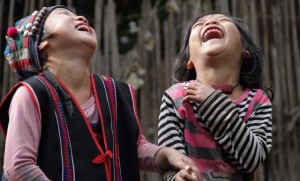 On 16 April, On the Road will be a live-auction sponsor at the annual Gala Dinner of a Hong Kong-based charity called Kids4kids. Our sponsored prize is for a family of four to join our “Family Adventures – Travel Photography in Yunnan” journey. We have designed this journey to inspire an interest in travel photography – the art of seeing beauty everywhere – something that might become a lifelong passion for children, and an activity that parents and children can share. In this world of “insta-” everything, having a chance to explore a new environment as a family and learning a new skill together provides a particularly meaningful break from the frenetic pace of everyday life.
On 16 April, On the Road will be a live-auction sponsor at the annual Gala Dinner of a Hong Kong-based charity called Kids4kids. Our sponsored prize is for a family of four to join our “Family Adventures – Travel Photography in Yunnan” journey. We have designed this journey to inspire an interest in travel photography – the art of seeing beauty everywhere – something that might become a lifelong passion for children, and an activity that parents and children can share. In this world of “insta-” everything, having a chance to explore a new environment as a family and learning a new skill together provides a particularly meaningful break from the frenetic pace of everyday life.
We are proud to be sponsoring several other charitable events in the months to come.
Happy Easter!
Over the Easter period, Angie and I will be in Europe. I’m selling it to her as a “holiday”. As she does every time, she will ask me “Do you call this a holiday?” Why? Because, during our trip we will be also researching a new itinerary that will run through the Czech Republic, Austria, Slovenia, Croatia and Italy (Fruili and Alto Adige). Whether business or pleasure – fortunately the two often overlap, we can’t wait to go!
We wish you, too, Happy Easter and a Peaceful Qing Ming!
Posted on 22 Mar, 2016
Burma’s jungles hide fabulous reserves of precious stones. Mines around the town of Mogok in Mandalay Division produce much prized “pigeon’s blood” rubies and beautiful sapphires. In Kachin State, Hpakant’s vast open-pit mines – visible on Google Earth – produce the world’s finest jadeite. And yet, rather than “Land of Rubies” or “Land of Jade”, Burma is known as the “Land of Gold”.
One reason, at least, is obvious from a casual walk around any Burmese town or village. Keep your eyes open, and the chances are that within a couple of minutes you’ll either spot the burnished gold of a pagoda at street-level, or see one glinting from a nearby hilltop.
Burma’s paya – a word usually translated as “pagoda”, although the majority resembles stupas more than Chinese-style pagodas – are almost universally covered with gold leaf or gold paint. Coating and recoating religious buildings with gold is one of the best ways for the building’s sponsors to earn religious merit.
Elsewhere, the gold covering is more of a collective effort, with worshippers queuing to buy tiny squares of delicate gold leaf sandwiched between sheets of tissue. Mandalay’s Mahamuni Buddha is a good example; the lower part of this revered Buddha statue, believed to be one of a handful cast during Buddha’s lifetime, has slowly been obscured by layers of gold leaf applied by male devotees (women must watch the action on a television screen outside). The gold is now estimated to be between 20–30cm or almost 12 inches thick!
One of the most fascinating places I visited on my research trip to Burma was one of Mandalay’s gold leaf workshops. Considered a sacred craft, the leaves are handmade by a process that has changed little for centuries. First, an ounce of gold is placed in a bamboo paper wrapper and pounded with a heavy hammer for 30 minutes before being cut into six smaller pieces. These pieces are then stacked and the process is repeated again and again until the sheet reaches the requisite thinness, as you can see in the following video:
Crafting gold leaves is hard, but it pays well and, according to Buddhist tradition, buys good karma. Only men are allowed to do the hammering, taking up the job at the age of 16 and retiring in their mid-forties when their bodies can no longer endure the work. Women work at cutting the gold leaves, a less respected role than the men’s. Both men and women work in stuffy, wind- and draught-proof rooms to cut the feathery sheets of gold leaf into smaller pieces.
The second and less immediately obvious reason behind Burma’s golden nickname is that both the Burmese and the Mon believe that a region of Lower Burma was once the site of Suvarnabhumi, a “Golden Land” mentioned in early Buddhist texts.
The town of Thaton in Mon State is supposed to have sat at Suvarnabhumi’s heart. Once the capital of a wealthy Mon kingdom, today Thaton is a sleepy little market town, where the only signs of a “golden land” are the pagodas that glint from the ridge behind the town, and the large Shwe Saryan pagoda complex next to the bus station.
As you can see, both of the reasons why Burma is known as the “Land of Gold” are intimately connected to its people’s strong Buddhist faith. Another story I was told during my trip attests to this strong link: many Burmese families do not have savings accounts, not because they don’t have any money to save, but rather because any surplus each month is spent on gold leaf and stuck on temple statues – savings for the next life, rather than this one, as it were…
Please click this link to our “A Burmese Journey – From the Golden Triangle to the Bay of Bengal”, that features a visit to a gold leaf workshop in Mandalay.
Posted on 15 Mar, 2016
(For Part I, click here)
The only way I can describe driving among the mountains on that day is as a sensation of near-flight. Gliding along the perfect mountain roads, I seemed to soar and sink, descend and climb, and in these motions partake in the sensations unique to flight, at once accelerating forward, upward and sideways. On those mountain roads, I felt like a hawk, lifted and dropped at a thermal’s whim. The road set my course as the wind directs a paraglider’s flight. At times, I slowly ascended on a straight path, while at others, I spiraled up around serpentine twists and – coming to a standstill – seemed to float in midair atop each saddle. With each pass crested, I swooped into the first tight hairpin bend, only to take off once again as I reached the bottom of each valley. That morning, I frolicked and played for hours, diving into broad valleys and cleaving a way between sharp peaks, forgetting about the world left underneath.
In the past – as was the case on this particular day – I had to steal a moment here or there to get my fix of mountain roads. Nowadays, it’s part of my job: I can’t believe my luck! In designing our European driving holidays, one pass that often features high on the list of “must-drives” is the Stelvio (or Stilfserjoch) at the eastern end of the Swiss-Italian border. With its 48 hairpin turns, it attracts not only drivers of cars and motorbikers, but also masochistic cyclists. For one reason or another, it has become the iconic Alpine pass and I am asked about it time and again.
So, last year when a client asked “Can we drive The Italian Job?”, I was taken aback. I hadn’t thought about the movie or the mountain pass featured in the original 1969 version of the film for a long, long time. “Of course,” I replied, relishing the thought that, in preparation for this client groups’ trip, I would be forced, as it were, to drive it ahead of time to re-familiarize myself with it.
Rather than the dramatic Stelvio Pass, The Italian Job features the Grand St. Bernard Pass, which straddles the Swiss-Italian border far to the west. This is the mountain pass that gave the St. Bernard dog its name. (I grew up with one of these furry, cuddly beasts, and always struggled to measure up to its size, much as my mom struggled to rid my clothes of its sticky, long hairs.)
Eventually, the day arrived, last June, when I drove the Grand St. Bernard again, retracing the legendary Italian-side ascent featured so beautifully in the opening scene of The Italian Job. While Rossano Brazzi drives his Lamborghini Miura through turn after turn, along this Alpine road on a gorgeous day, the song On Days Like These plays in the background. Never in the history of movie-making has a song matched the emotion evoked by the opening sequence of a film so well.
In my case, it was a lovely spring day and I was on my way from Milan to Gstaad in Switzerland. These days, the main road through the Aosta Valley goes through an ugly tunnel from Italy into Switzerland. If you want to drive over the pass, as I did, you have to pay attention to find the right turn-off, otherwise you might zip right past it.
The Italian Job road is relatively short, but what it lacks in length it compensates for with scenic beauty and spectacularly twisting bends. Its curves are just as enjoyable to drive as those of the Stelvio, if not more so: some of the Stelvio tornante are downright hard work, and drivers that miscalculate are forced, embarrassingly, to make a three-point turn. The Grand St. Bernard’s corners are gentle and a breeze to drive. Nerd that I am, I started playing On Days Like These, cranked up the volume, rolled down the window and opened the sunroof for the climb to the pass. The meadows were covered with spring flowers – I stopped a few times to smell them and take photos – and at the top, as spring gave way to vestiges of winter, I saw patches of snow. After parking my car by the lake that graces the pass, I got out, leant against the bonnet, turned my head toward the sun and closed my eyes to listen to the birdsong that floated on the breeze.
Indeed, on days like these…
Please click this link an example of one of our On the Road in Europe itineraries that features the Grand St. Bernard Pass.
Posted on 5 Mar, 2016
For most people and much of human history, mountain passes evoked visions or memories of anything but pleasure. Instead, they were associated with the pinnacle of hardship as traders, exhausted and starving, struggled to carry their wares across mountain ranges wrapped in deep snow and whipped by ferocious winds. Or they were frozen graveyards of soldiers since mountain ranges formed natural boundaries turned political borders. Mountain passes were the places where one came face-to-face with the enemy and the violence of war.
How different my world is. I grew up in the heart of the Alps and in a period of peace and unprecedented wealth creation: there are fabulous roads to drive across the Alps and the only enemy I recall encountering at the top of a mountain pass was a bird that shat into my open-top car while I got myself a grilled sausage from a stand by the roadside.
According to one website for motorbikers, there are over 300 mountain passes dotting the Alps. I must have driven across at least a third of them, including some of the highest, like the Col de la Bonette in eastern France.
(When I drove across this one many years ago I felt quite proud, though I’ve since driven over a mountain pass on the S304 in Tibet that’s early twice as high, topping out at 5,450m.)
Once, on one day alone, I crossed fifteen Alpine passes. On days like these, when I have the luxury of driving for fun, the agony of waking to the sound of an alarm clock in the early hours of the morning was almost instantaneously replaced with eager anticipation of the treat to come. In no time, I was up, dressed, had put on my soft driving shoes (all the better to work the pedals), and had rushed out to my car.
On that morning I started off in Bregenz, an Austrian town by Lake Constance. At first, with the early morning temperature hovering around five degrees Celsius, the car’s engine was still cold, not ready to be put through its paces. The engine spluttered and vibrated edgily in its compartment. But by the time I reached the city boundaries, heading south, it was purring and I was raring to go.
When the last of the city’s stop-lights turned green, it threw open the road before me. I sped up and found myself rushing toward immense beauty: the black, purple, pink and orange of dawn in the Rhine valley. There was the instant thrill of being pressed into my seat, feeling the engine coming, then coming again, and again, as I shifted through the gears. It was a sensation of total immersion and bursting free, both at the same time.
About an hour later, the sun rose and divided the world in two, the still-dark valleys below and the glorious mountains above. In fact, I had finished climbing the first mountain, the Bielerhöhe, which separates Austria’s two western-most states, and was already descending into a Tyrolean valley, negotiating hairpin turns on the way down, one after another.
The only way I can describe driving among those mountains on that day is as a sensation of near-flight…
Come back for the continuation of On days like these … soon…
Posted on 2 Mar, 2016
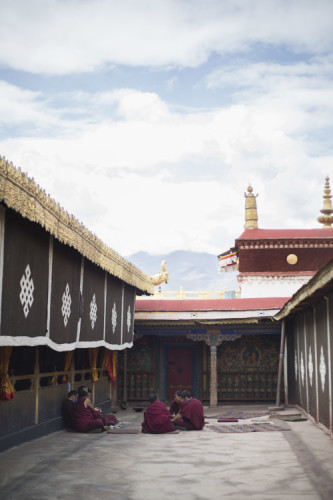 When I was working on The Rough Guide to Burma, I spent a week staying in a hotel in Hpa-An, Kayin State’s laidback capital, while I explored the surrounding region. One of my fellow guests was a slight, red-haired German man who wore wire-rimmed spectacles and a striped Kayin longyi, and spent afternoons drinking tea and reading on the hotel’s shady balcony. Intrigued as to why he didn’t seem to be going anywhere – other backpackers moved on after two or three nights – I eventually struck up conversation with him to find out why.
When I was working on The Rough Guide to Burma, I spent a week staying in a hotel in Hpa-An, Kayin State’s laidback capital, while I explored the surrounding region. One of my fellow guests was a slight, red-haired German man who wore wire-rimmed spectacles and a striped Kayin longyi, and spent afternoons drinking tea and reading on the hotel’s shady balcony. Intrigued as to why he didn’t seem to be going anywhere – other backpackers moved on after two or three nights – I eventually struck up conversation with him to find out why.
The man was actually on his third week in Hpa-An – this being the first major town he’d reached after crossing the border from Thailand. He’d arrived from with a two-week visa that he had used before returning to Bangkok for a second visa, which he was halfway through at the time of our conversation. “I just like to travel this way; I take a month off each year, and when I reach somewhere nice I’ll stop for a couple of weeks and spend my days exploring slowly and relaxing.”
Now, I write a blog that’s nominally about slow travel – a style of travel that I find very appealing and very unachievable, as I always end up in a mad dash to somewhere or other – so I began to enthuse about his slow travel philosophy and how everyone should travel like this (let’s put my own inability to do so aside for the moment). He politely let me go on for a bit before interrupting: “The main thing, I think, is that each of us gets satisfaction from our travels. Going so slowly would not suit everyone, it’s just important to know what you want to get out of your trip…”
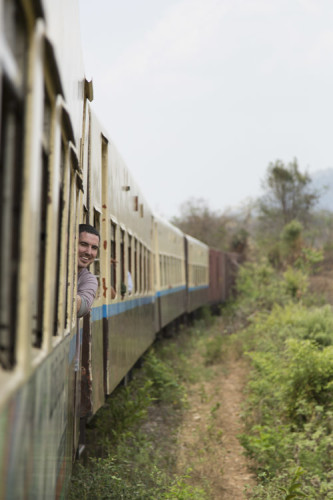 And, of course, he’s right. But it strikes me that, with websites and magazines churning out lists of “must-sees”, “hot destinations” and “places to see before you die”, it is easy to get distracted and forget how you originally wanted to spend your travel time. Perhaps the best balance to strive for is between keeping an open mind and trying new things, and doing so in a way you find meaningful and fun.
And, of course, he’s right. But it strikes me that, with websites and magazines churning out lists of “must-sees”, “hot destinations” and “places to see before you die”, it is easy to get distracted and forget how you originally wanted to spend your travel time. Perhaps the best balance to strive for is between keeping an open mind and trying new things, and doing so in a way you find meaningful and fun.
That might mean taking the time to hunt down a special flavour of gelato in Florence rather than visiting another church; or sipping a cup of sweet tea in a Yangon teahouse rather than dutifully tramping around another yet pagoda; or blinking in bright sunshine from the roof of the Jokhang in Lhasa, rather than queuing to enter the crowded chapels below. Whatever it is that you enjoy, take time to seek it out and soak in the experience, rather than following crowds or fashion – go your own way.
Posted on 25 Feb, 2016
The small Yunnanese town of Yuanyang is famed for the steep tiers of rice terraces that snake across hillsides around the town. In winter, dawn light sparkling off the watery fields attracts legions of photographers eager to capture the sight on film – a group of On the Road photographers is about to leave for the region next week.
While many visitors come for the landscape, Yuanyang’s human side – the Hani farmers have worked the terraces for generations – is well worth exploring too. A few years ago, we were searching for a way to incorporate more contact with local communities into our itineraries. One of our guides, Zoe, had befriended the bellhop at Yuanyang’s Yunti Hotel, and he offered to introduce us to his uncle, who was the headman of a village amongst the rice fields.
One day in May, we set out from Yuanyang with a group of Swiss guests to meet the uncle and visit his village. The wisps of mist that enshrouded the rice fields slowly burnt off over the course of the walk to the village as our guests peppered the uncle with questions about village life.
The uncle took us to a house in the centre of the village. We had to duck to get through the door, and groped our way up a steep, dark staircase with a rope for a railing. The upstairs room was dark and smoky from cigarettes and an open fireplace, with a single window that allowed a cone of light to illuminate the room. Eight low stools were arranged around a small table for us. Our guests’ faces betrayed a mixture of delight – oh so exotic and friendly! – and fright – where had I taken them to?
We took our seats and while the Q&A session continued – what is the main trade of the village? Do you have a school? How many inhabitants are there? What’s the average income? What do you think about the future? How many people live in your house? — lunch began to be served. The plates gradually accumulated – at first two dishes, then four, then eight, then twelve, they just kept coming.
Eventually, the mayor motioned for us to begin eating when Zoe suddenly started crying and burst into almost uncontrollable tears. We all looked at her, unsure what to do. I patted her on the shoulder and asked, “Zoe, what’s wrong?”
“Nothing, it’s nothing, really,” she managed to say between sobs, “it’s just that, look, look at all this food! These poor people are serving up all this for us, but maybe they would only eat like this once a year themselves, maybe never in their lives…” As Zoe spoke, a guest, Edith, got up and walked to Zoe, pulled her to her feet and gave her a warm hug.
No words were spoken while Zoe and Edith stood there hugging, but perhaps for a moment we all felt linguistic and cultural barriers giving way to a moment of shared emotion. At a time when nationalistic fires are being fanned around the world, it seems a timely reminder that behind the headlines there are millions of ordinary people, like the bellhop’s uncle, and like Zoe and Edith, who are making their way through life, trying to do the best for their families, and trying to lead good lives. Travel is one fantastic way to remind ourselves of this, and as Mark Twain put it in The Innocents Abroad, adapted somehow for this story:
“People need travel sorely. Broad, wholesome, charitable views of men and things cannot be acquired by vegetating in one little corner of the earth all one’s lifetime. Travel, then, is fatal to prejudice, bigotry and narrow-mindedness.” Let us celebrate these fatalities!
On the Road takes you to Yuanyang rice terraces on these journeys:
- Photography with Ron Yue – Yunnan through a Lens: Red Earth and Fields of Gold
- Photography with Ron Yue – Yunnan through a Lens: The Exotic South
- Discovery – From Yunnan to the Lanna Kingdom
Posted on 26 Jan, 2016
This Easter, we will return to Slovenia for the second time in as many years. Yet until 2015, I’d hardly heard the country’s name, despite growing up in neighbouring Austria. Suddenly, Slovenian connections seem to be emerging all over the place.
|
When I was growing up in Austria in the 60s and 70s, Slovenia was part of Tito’s Yugoslavia and lay behind the Iron Curtain. In my imagination, anything connected to the USSR was rendered in monochrome – inaccessible, undesirable, and forbidden. Why would anyone want to go there? I never had cause to reconsider this attitude until about a year ago, when my wife, Angie, and I began planning a trip to Croatia. Angie, who is originally from Malaysia, mentioned this casually to her sister Denise when visiting her last year in Melbourne. “You’re going where?!” exclaimed her sister. “Croatia’s right next to Slovenia. My best friend is from there.” Thirty minutes later Denise’s friend Renate had joined us to tell Angie all about Slovenia. |
A few facts about Slovenia…
Slovenia is a small central European country with a population of just two million. Part of the Austro-Hungarian Empire until it became independent at the end of World War I, Slovenia shares Austria’s mountainous geography. Since joining the EU in 2004, Slovenia has become a moderately well-to-do and modern country, yet has retained a rustic and unspoiled charm. Slovenia produces wonderful wines (mostly whites but also reds) and has endeared itself to us for family restaurants that serve hearty food “like grandma used to make”.
Several of our On the Road in Europe itineraries visit Slovenia (for example, this itinerary here). In 2017 we will be launching an Eastern Europe itinerary that will include the Czech Republic, eastern Austria, Slovenia, Croatia and Northern Italy. |
“If you do go to Slovenia, I’ll introduce you to my cousin Sanja. You can stay with her!” Just three months later Angie and I met Sanja and her husband Davorin. The couple live and work in Slovenia’s largest national park which takes its name from the country’s tallest mountain, Triglav. Sanja works in a drugstore; Davorin’s work is connected to the national park authority. They have three sons who could be the envy of any parent: courteous and lively, they come home from school to work on the family farm without their parents’ prompting. Much of what the family eats comes from their own land.
After Angie’s meeting with Renate, our trip to Croatia expanded to take in Slovenia as well. While researching our itinerary we thought it
would be nice to stop at some vineyards along the way. A friend recommended Movia, one of Slovenia’s finest winemakers. The vineyard’s owner, Ales, is one of a kind, we heard. Wouldn’t it be something to meet him?
When we plan our holidays, Angie researches the hotels and restaurants; I pick the roads in between. On February 10th last year, we pulled up in front of one of Angie’s selected restaurants, Danilu, on the outskirts of Ljubljana and a member of Jeunes Restaurateur d’Europe. We were served by a fizzy young lady who turned out to be the owner’s daughter. Besides helping out in the family restaurant, she runs a night club and, to our great surprise, counts Movia’s owner Ales among her close friends. A week later we met Ales, shaking his enormous farmer’s hands, and spent an entire afternoon tasting his beautiful wines in his firelit tasting room.
Sinuous roads lead through the Triglavsky park – one, narrow and steep, leads across a tall pass from Kranjska Gora to Soca; another enters from Italy. Less winding, the latter meanders across a lower pass and traces the course of a beautiful river. I could drive on these roads for hours without getting bored: how could one when immersed in this lovely landscape and dreamily following the curvy tarmacked ribbon of road?
We were driving through Triglavsky National Park earlier this year when I suddenly noticed something I hadn’t seen for a while. It was one of those double-take moments: did I just see what I saw? I turned around and back-tracked and then stood in front of, well, was I still in Slovenia? Or had I been transported to Tibet? Right there, in front of me, there were little cairns of stones that I had last seen along the road to Mt. Everest: sacred piles of stones that are constructed to fend off evil and bring good fortune. How had they been transported to Slovenia?
I find myself pondering how it can be that I had to go from Austria to Tibet and then via Malaysia and Australia only to discover Austria’s neighbor Slovenia and its unfathomable connections to places impossibly remote from it.
Sometimes it’s the things planned well in advance that make a journey special, like Angie’s restaurant choices or a particular route I’ve chosen, but at other times it’s the magic of serendipity – a chance collision of people and places – that transforms a journey into a really exceptional experience.
